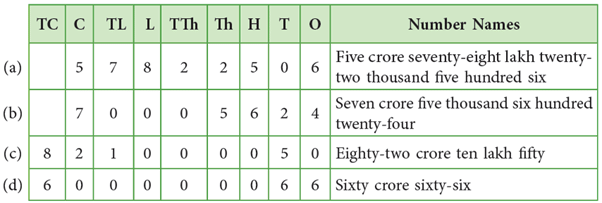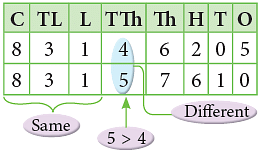Large Numbers Class 5 Notes Maths
Ria & Some Big Big Numbers!
While reading the newspaper, Ria read that the population of India is more than 100 crores and that of Delhi is about 2 crore 50 lakh.
- She wondered, how much will a crore be, and on asking the teacher, she realized that a crore is a large number.
 Ria wondered how much will a crore be?
Ria wondered how much will a crore be?
All about One Crore!
In order to understand what One Crore is, we need to understand what One Lakh is:
- One Lakh is the number 100000.
The number 100000 is one hundred thousand or 1 lakh.
It is a 6-digit number including 5 zeros.
Number 100000 is the smallest 6 digit number.
Have a look at the smallest 6,4,3,2 & 1 digit numbers below.
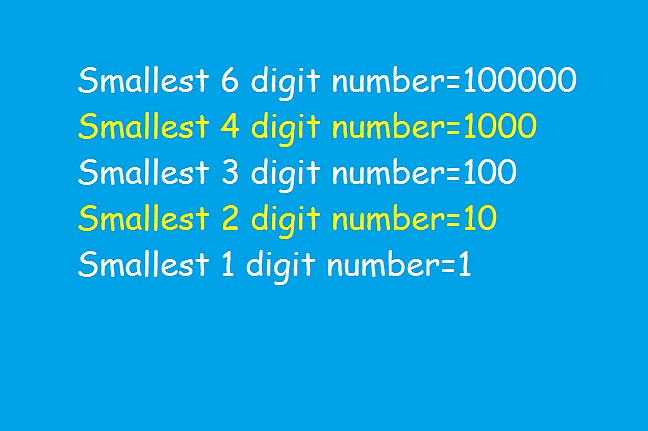
We learnt about One Lakh! Come on! Let’s learn about 100 Lakh or One Crore now!
- The number 10000000 is read as (100 lakh) or 1 crore.
- Yeaaaa! 100 Lakh is One Crore!
- Similarly, 50000000 is read as ‘five crores’.
- 80000000 is read as ‘eight crores’.
Wooohoooo! You and Ria have mastered the concepts of Crore now!
- One Crore is the number 10000000 or 100 Lakh and 1 lakh is the number 100000 or One Hundred Thousand.
Do you know?
The moon is approximately 384400 km away from the Earth. It is a huge number as well!
In the image Earth and Moon look very near but it in reality it isn't so.
Greatest Digit Numbers
- Have a look on Greatest 5 digit number.

Tell us!
Which is the greatest 8 digit number and how can we get the smallest 9 digit number from it?
- 99999999 is the greatest 8-digit number and is read as ‘nine crore ninety-nine lakh ninety-nine thousand nine hundred ninety-nine.
- If we add 1 to this number, we get the smallest 9-digit number.

- 100000000 is read as ‘ten crore’.
- Similarly, 200000000 is read as ‘twenty crore’.
- 400000000 is read as ‘forty crore’.
Tell us again!
Which is the greatest 8 digit number and how can we get the smallest 9 digit number from it?
- 999999999 is the greatest 9-digit number and is read as ‘ninety-nine crore ninety-nine lakh ninety-nine thousand nine hundred ninety-nine’.
- If you add 1 to this number, you will get the smallest 10-digit number. 1000000000 is read as ‘hundred crore’ or ‘one arab’.
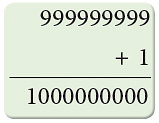
What are Place Values?
Place value in Maths describes the position or place of a digit in a number. Each digit has a place in a number.
- When we represent the number in general form, the position of each digit will be expanded.
- Those positions start from a unit place or we also call it one’s position.
- The order of place value of digits of a number of right to left is units, tens, hundreds, thousands, ten thousand, a hundred thousand, and so on.
- Let us understand with the help of an example, say 7231468, and see below figure for the place value of each digit.
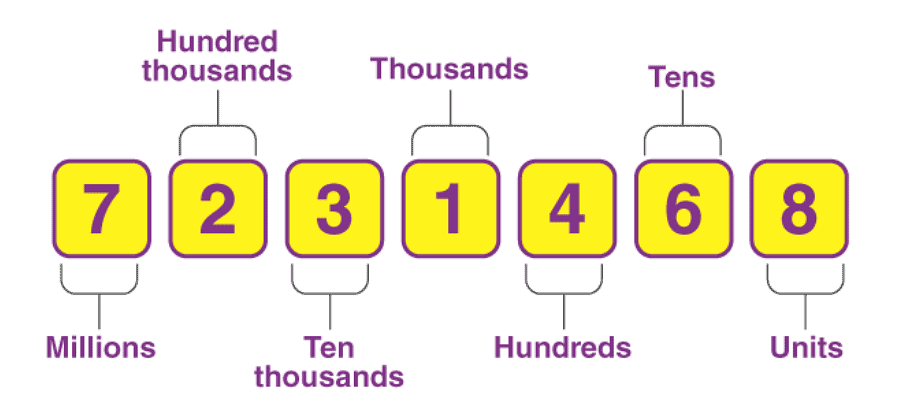 Place Value of number 7231468
Place Value of number 7231468
- Look at the place value chart below for the first nine digits in the Indian system of numeration.
 Place Value Chart Indian system of Numeration
Place Value Chart Indian system of Numeration
- The first period consisting of three digits is called units or ones period, the next period consisting of two digits is called thousands period.
- Next period also consisting of two digits is called lakhs period and the next period which also consists of two digits is called crores period.
How to Read Large Numbers?
- To read a large number, divide the number into periods starting from the right.
- For separating periods, we put a comma after three digits starting from the right and then we put a comma after every two digits.
- The modern convention is to leave space to separate different periods instead of putting a comma between them. Thus, the numbers 75,80,72,608 would be written as 75 80 72 608.

- While reading a numeral, all the digits in the same period are read together and the name of the period (except the ones) is read together.
- Thus, the above number is read as ‘seventy-five crore eighty lakh seventy-two thousand six hundred eight’.
Edurev Tips:
- We should not write the word ‘and’ here as per the common practice.
- We do not use the words indicating the periods in plural form. Thus, we write seventy-five crore and not seventy-five crores.
The population of Japan in the year 2018 was about 12,71,85,332.
- A place value chart can help to explain what the number means.

- The different ways in which 12,71,85,332 can be written are:

Example 1: Write the numeral for the following by separating the periods.
(a) 603274087
(b) 37007690
Starting from the right, first make a group of 3 digits, then groups of 2 digits.
Put commas between different groups.
Thus, we write
Example 2: Write the number names for each of the following numerals.
(a) 5 78 22 506
(b) 7 00 05 624
(c) 82,10,00,050
(d) 60,00,00,066
First, we arrange the digits of the given numbers in the place value chart as shown below and then write their number names.
How to Compare Large Numbers?
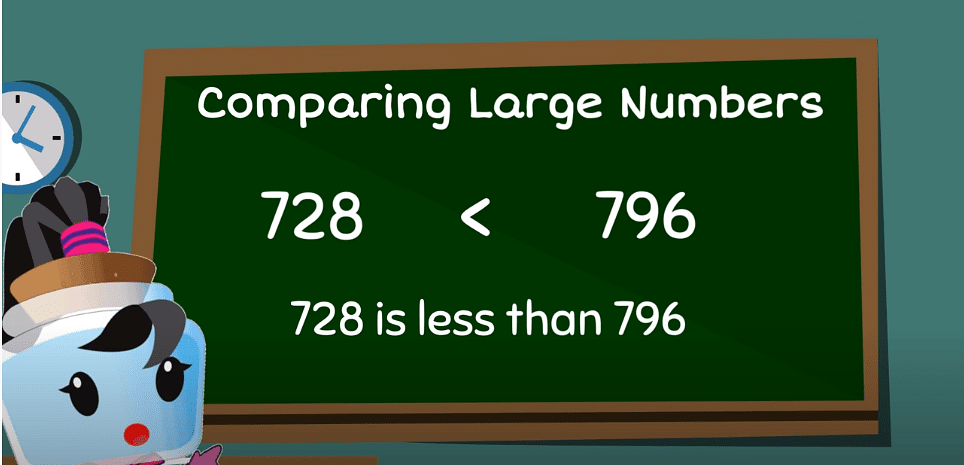 Comparing Large Numbers
Comparing Large Numbers
Rules: To compare numbers with:
(a) Unequal number of digits: the number having more digits is greater than the number having fewer digits.
(b) Equal number of digits: start from the left and compare the digits until they differ.
Example 1: Which is greater: 8,93,10,009 or 11,00,73,640?
Lining up the numbers by place values, we have
11,00,73,640 has 9 digits whereas 8,93,10,009 has 8 digits and 9 > 8.
So, 11,00,73,640 > 8,93,10,009.
Example 2: Compare 8,31,46,205 and 8,31,57,610.
Line up the numbers by place values and compare the digits from the leftmost place until they differ.
The digits differ at the ten thousands place.
∵ 5 > 4, ∴ 8,31,57,610 > 8,31,46,205.
How to form Smallest and Greatest Numbers from a given Number?
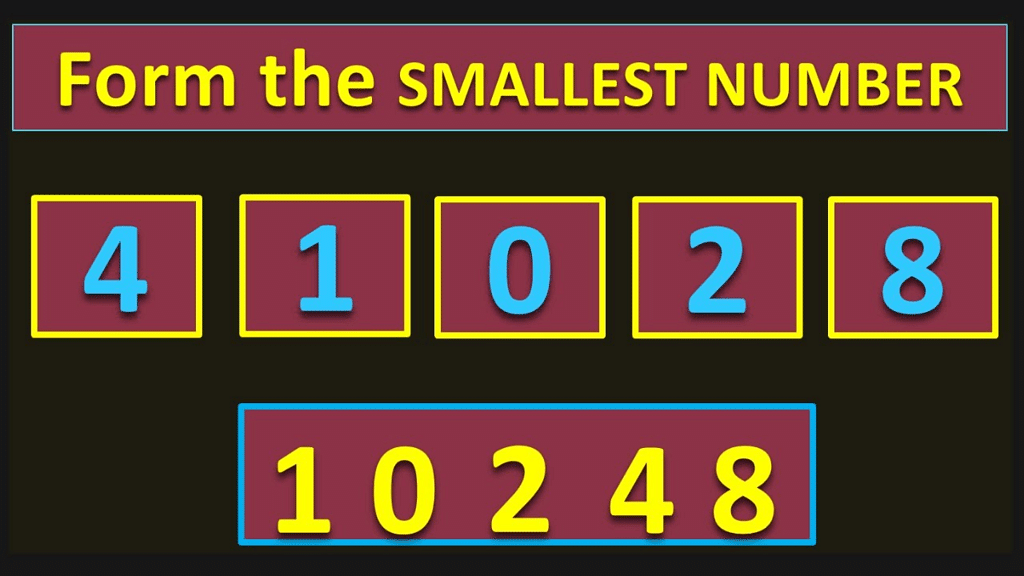 Smallest number from digits 4,1,0,2,8 is 10248
Smallest number from digits 4,1,0,2,8 is 10248
The smallest number that can be formed with the digits 4,1,0,2,8 is 10248
Case 1: Form smallest/ greatest number when repetition of digits is not allowed
Example 1: Write the greatest 6-digit number using the digits 3, 2, 9, 5, 6, and 8 only once.
For writing the greatest 6-digit number, we place the greatest digit at the leftmost place and the other digits in descending order.
So, the greatest 6-digit number is 986532.
Case 2: Form smallest/ greatest number when repetition of digits is allowed.
Example 1: Form the greatest and the smallest 8-digit numbers using each of the digits 2, 8, 0, and 1 twice.
The greatest 8-digit number = 88221100.
The smallest 8-digit number = 10012288.
International System of Writing Numbers
- The number 100000 is read as one hundred thousand or 1 lakh. It is a 6-digit numeral.
- In the International System, the number 10 lakh or ten hundred thousand, that is, a thousand thousand, is called a million.
- It is written as under:

Instead of lakhs, crores, etc. as periods, we use millions, billions, etc.
- Let us write the smallest 8-digit number in the two systems of numerations.

- The International place value chart is given below.

- The chart can be extended to its left to include more than 9 places.
- The period just to the left of the millions period is called the billions period. Then, we have the trillions period.
- The places to the left of the hundred billions places are called trillions place, ten trillions place, and hundred trillions place.
- On comparing the two systems of numerations, we can observe the following relationships.

- Note that in the Indian system, starting from the right after the first period of 3 digits all other periods are of 2 digits but in the International system, each period consists of three digits. We place a comma or leave space after every 3 digits.
- The abacus shows the number ‘six million eight hundred forty-nine thousand two hundred forty. To make the task of reading and writing such large numbers easy, start counting digits from the right by threes and leave some space or put a comma after every three digits as shown below.
 Writing number 6,849,240 in International System of Writing Numbers
Writing number 6,849,240 in International System of Writing Numbers
- On writing the above number in Indian system, we get 68,49,240. It is read as sixty-eight lakh forty-nine thousand two hundred forty.
 Did You Know?
Did You Know?
Example 1: Write in numerals.
(a) 4 million
(b) 11 million
(a) 4 million = 4 000 000 Or 4,000,000
(b) 11 million = 11 000 000 Or 11,000,000
Example 2: Using the International system of numeration, write the numeral for each of the following.
(a) Seventy-four million three hundred forty thousand two hundred fifty-six.
(b) Sixty-eight million two hundred thousand three hundred twenty-four.
(c) Five hundred nine million seven hundred seventy-six thousand two hundred thirty.
Writing in the place value chart, we have:
So, the numerals are:(a) 74 340 256
(b) 68 200 324
(c) 509 776 230
|
58 videos|122 docs|40 tests
|
FAQs on Large Numbers Class 5 Notes Maths
| 1. What is the significance of One Crore in large numbers? |  |
| 2. How are place values important in reading large numbers? |  |
| 3. How can one compare large numbers effectively? |  |
| 4. How can the smallest and greatest numbers be formed from a given number? |  |
| 5. What is the International System of Writing Numbers? |  |

|
Explore Courses for Class 5 exam
|

|





